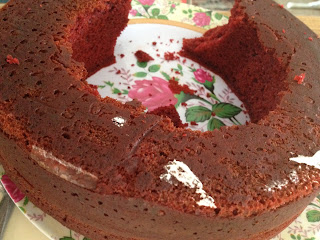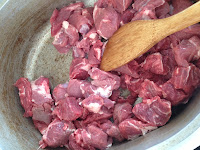So yesterday I made my first goose. Actually, when I was about 11 years old, my dad and I made our first goose. The smell in the house was horrible, and we ended up giving the meat to the dogs. We didn't have an oven, so the goose was boiled on the stove. I just remember the pot boiling furiously, and having to skim off the abundance of oil from the top.
Yesterday we had an Olde English themed Christmas party. We dressed up in Englishwear, and brought many dishes like Yorkshire Pudding, Kilted Sausages, Roast,
real Port Canberry Sauce, Brussel Sprouts, Christmas Pudding, English Trifles, Mincemeat Pie, and of course this Roasted Goose. Everything was really delicious, especially the Founder's Reserve Porto (Port Wine) and Madeira wine I was drinking!! However, the goose was quite a hit (mostly because it was a different type of meat no one was really used to).

Finding the goose was a pain. Here in America, goose is not very popular. So good luck trying to find it if it's not the holiday season. I started my goose hunt early last month . I called every poultry, meat, butcher on the island and no one had it. Much to my suprise though, Safeway of all places had it! I didn't know if it was going to run out by Christmas, so I immediately picked one out and bought it. Oh! By the way, plan on spending $80 for your 10 lb goose (ridiculously expensive, but I was desperate). Luckily, Safeway was having a Thanksgiving sale and my goose got $20 knocked off with my Safeway card! When December rolled around, I found out a 10 lb goose would only feed 4-6 people, so I went back to Safeway to get myself another goose. Good thing I walked in during the Christmas sale and got the same price.
I spent 2 months trying to find out how to roast the goose, watching YouTube videos, checking out blogs, and getting seriously annoyed that almost every recipe used the metric system! But alas I had found a wonderful recipe over at
Simply Recipes, and combined it with
Martha Stewart's recipe to create my own. I hope you enjoy.
ROAST GOOSE w/ GRAVY
(serves 4-6)
ingredients:
1 10 lb goose
1 apple
2 large yellow onions
10 sprigs of fresh sage
1 head of garlic
salt
pepper
3 tablespoons flour
1/2 cup Madeira wine
(took me forever to find this wine! Located in the section with Port, most likely by the Sakes)
2 cups chicken stock
1 teaspoon thyme
Geese usually come frozen. To prevent any type of contamination or food poisoning, the best way to defrost is to do it in the refrigerator for a couple days. If you don't have a few days, find a container large enough to hold your goose, place it in, and fill with water. Every 30 minutes the water needs to be changed, and this must be done for 6 hours. Leaving your bird out on the counter is the worse way to thaw your bird. The temperature on the outside of the bird will thaw faster than the cavity, allowing bacteria to multiply rapidly over the skin.
method:
Preheat your oven to 400 degrees F. Prepare your goose by unlooping the legs then removing neck and giblets from the cavity. Peel off all large chunks of fat at the opening and reserve to render out. Break off wing tips by cutting around the joint, and snapping off. Trim the neck skin, and reserve with the fat. Completely rinse bird with hot water (only if goose is still cold, otherwise use cool water). Pat dry with lots of paper towels, and inspect/remove all pin feathers. Prick the skin of the goose with the tip of a sharp knife (being careful not to pierce the meat). This will help the fat to drain out of the bird, but keep the juices in.

Next, season the entire bird with salt and pepper. Use more salt than you think, this will help crisp the skin as well as give a nice flavor to the bird. Don't forget to season the inside of the cavity. Turn the bird over, and using 2 toothpicks pin down the neck flap flat against the back. If you'd like to use other seasonings such as dried rosemary, sage, or thyme you can use that to season the bird as well. I just wanted a slight perfume of seasoning, so I used fresh sage on the inside of the cavity. You will find that the salt will start to draw out some of the juices, and your bird will no longer be dry.
Cut one onion and apple in half, and peel all cloves of garlic. Stuff it inside the goose cavity along with sage sprigs. Pull the cavity flaps together to close, and squeeze the legs together to help keep them shut. Tie the legs back together with the loop of skin, and try to double it to keep it tight. Using pieces of foil, wrap the tips of the wings to prevent them from burning.
Place in a roasting pan filled with 2 cups of water fitted with a rack, and place in the hot oven. Bake for 50 minutes, then turn the heat down to 325 degrees, and bake for 1-1.5 hours or until a meat thermometer registers 170 in the thickest part of the thigh (not touching the bone). Using a turkey baster, remove oil from pan throughout the cooking process, and replenish with boiling water. Goose is safe to eat medium rare to slightly pink. Once well-done the meat becomes chewy and livery tasting.

During roasting, start gravy. In a large heavy skillet or pot, brown the goose neck, wing tips, and giblets in some goose fat (discard liver, or cook seperately and add to gravy later - this will make your gravy bitter if cooked together). Chop or grate your onion, and throw it into the pot. Add more goose fat if your pot has become too dry. Once the onions have started to become transluscent, add the flour and cook for 3-4 minutes or until the smell has become toasty. Turn the heat up to high, and add the Madeira wine. Allow to boil for a minute or so while scraping the bottom of the pot, to loosen any stuck on bits. Add chicken stock and bring the gravy down to a low simmer. Add dried thyme, and a few chopped sage leaves if you desire. Skim off any oil that raises to the top. Keep simmering until the gravy has reduced.
Once your goose is done, allow it to rest for 20 minutes. Remove wing foil, onion, apple, sage, and garlic from cavity. Chop up garlic and place into gravy pot. Remove neck and wing tips, and pick off any meat and throw back into pot. Pour gravy into a blender and blitz it until smooth, or strain it through a sieve. Pour into a gravy boat, or keep it warm on low heat. Place goose on a serving plate, or carve and serve up warm with gravy.
With the reserved fat and neck skin, place in a small sauce pan and place on low heat. Using a turkey baster, siphon out juices and place in a glass jar. Once fat has been completely rendered, use baster to siphon out just the fat into a glass jar. Do the same with the roasting juices, and you'll have a large jar full of "liquid gold" as they call it. Goose fat is wonderful for frying, roasting potatoes, and keeping meat moist while roasting.

































